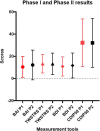Longitudinal Follow-Up of Mood in Cervical Dystonia and Influence on Age at Onset
- PMID: 35844277
- PMCID: PMC9274366
- DOI: 10.1002/mdc3.13457
Longitudinal Follow-Up of Mood in Cervical Dystonia and Influence on Age at Onset
Abstract
Background: Anxiety and depression are highly prevalent conditions in cervical dystonia and considered intrinsic to the disease mechanism. Psychiatric symptoms do not appear to be influenced by botulinum toxin therapy. Studies focusing on changes in mood disorder during the course of the disease are limited in this chronic, lifelong disorder.
Objective: To assess the longitudinal prevalence of mood disorder, pain, and quality of life in patients with cervical dystonia attending a botulinum toxin clinic.
Methods: Patients involved in phase I of our study were invited to be involved in reassessment using the Beck Depression Inventory, Second Revision; Beck Anxiety Index; Cervical Dystonia Impact Profile-58 (CDIP-58); and the Toronto Western Spasmodic Torticollis Rating Scale-2 Pain Scale (TWSTRS2-Pain).
Results: A total of 53 participants took part after a mean study interval duration of 24 months. There were no significant differences between the 2 study time points in the prevalence of anxiety (P = 0.2919) and depressive symptoms (P = 0.5). Self-reported quality of life by CDIP-58 (P = 0.96) and pain by TWSTRS2-Pain (P = 0.9321) were unchanged. Men and women with significant symptoms of mood disorder had an earlier age of onset of cervical dystonia (P = 0.008).
Conclusion: Anxiety and depressive symptoms persist in cervical dystonia, seem to be unrelated to pain severity, and need to be specifically targeted to improve quality of life. The relationship between mood disorder and age of onset suggest that mood disorder may be part of the disease pathophysiology.
Keywords: anxiety; cervical dystonia; depression; longitudinal; quality of life.
© 2022 International Parkinson and Movement Disorder Society.
Figures

Similar articles
-
Reliability of DNMSQuest as a Screening Tool for Mood Disorders in Cervical Dystonia.Mov Disord Clin Pract. 2021 Jul 8;8(6):925-931. doi: 10.1002/mdc3.13273. eCollection 2021 Aug. Mov Disord Clin Pract. 2021. PMID: 34405100 Free PMC article.
-
Trust the Patient Not the Doctor: The Determinants of Quality of Life in Cervical Dystonia.Front Neurol. 2020 Sep 4;11:991. doi: 10.3389/fneur.2020.00991. eCollection 2020. Front Neurol. 2020. PMID: 33013654 Free PMC article.
-
Cervical dystonia and quality of life.Acta Neurol Belg. 2016 Dec;116(4):589-592. doi: 10.1007/s13760-016-0634-1. Epub 2016 May 2. Acta Neurol Belg. 2016. PMID: 27138215
-
Botulinum toxin B: a review of its therapeutic potential in the management of cervical dystonia.Drugs. 2002;62(4):705-22. doi: 10.2165/00003495-200262040-00011. Drugs. 2002. PMID: 11893235 Review.
-
Pain Relief in Cervical Dystonia with Botulinum Toxin Treatment.Toxins (Basel). 2015 Jun 23;7(6):2321-35. doi: 10.3390/toxins7062321. Toxins (Basel). 2015. PMID: 26110508 Free PMC article. Review.
Cited by
-
Understanding Anxiety in Cervical Dystonia: An Imaging Study.Mov Disord Clin Pract. 2024 Aug;11(8):1008-1012. doi: 10.1002/mdc3.14070. Epub 2024 May 15. Mov Disord Clin Pract. 2024. PMID: 38747154 Free PMC article.
-
Cognitive and Neuropsychiatric Impairment in Dystonia.Curr Neurol Neurosci Rep. 2022 Nov;22(11):699-708. doi: 10.1007/s11910-022-01233-3. Epub 2022 Oct 6. Curr Neurol Neurosci Rep. 2022. PMID: 36201146 Free PMC article. Review.
-
Longitudinal predictors of health-related quality of life in isolated dystonia.J Neurol. 2024 Feb;271(2):852-863. doi: 10.1007/s00415-023-12022-4. Epub 2023 Oct 15. J Neurol. 2024. PMID: 37839041 Free PMC article.
-
Memory-Guided Saccades and Non-Motor Symptoms Improve after Botulinum Toxin Therapy in Cervical Dystonia.J Clin Med. 2024 Sep 25;13(19):5708. doi: 10.3390/jcm13195708. J Clin Med. 2024. PMID: 39407768 Free PMC article.
References
-
- Williams L, McGovern E, Kimmich O, et al. Epidemiological, clinical and genetic aspects of adult onset isolated focal dystonia in Ireland. Eur J Neurol 2016;24(1):73–81. - PubMed
-
- Waddy HM, Fletcher NA, Harding AE, Marsden CD. A genetic study of idiopathic focal dystonias. Ann Neurol 1991;29(3):320–324. - PubMed
LinkOut - more resources
Full Text Sources

